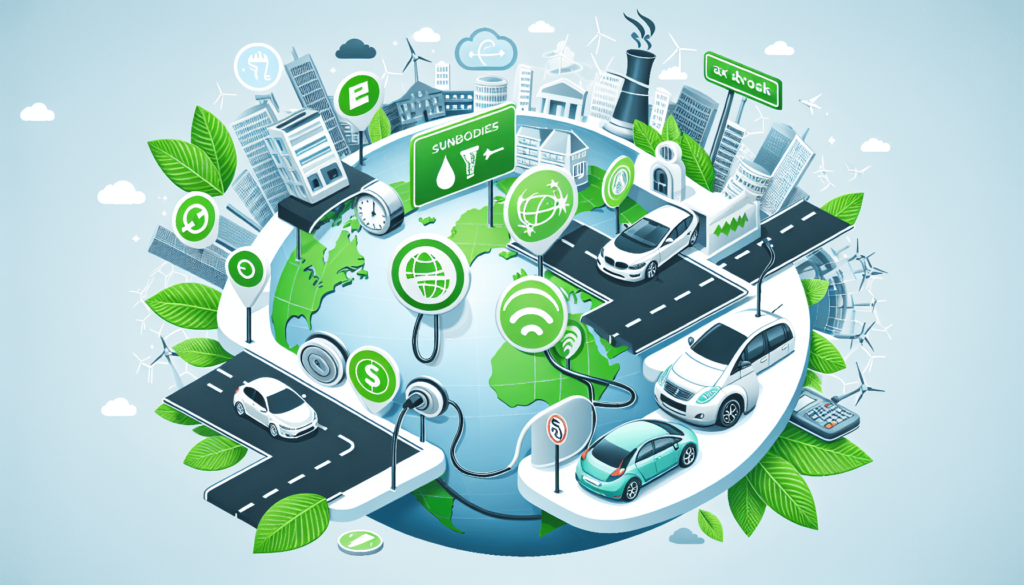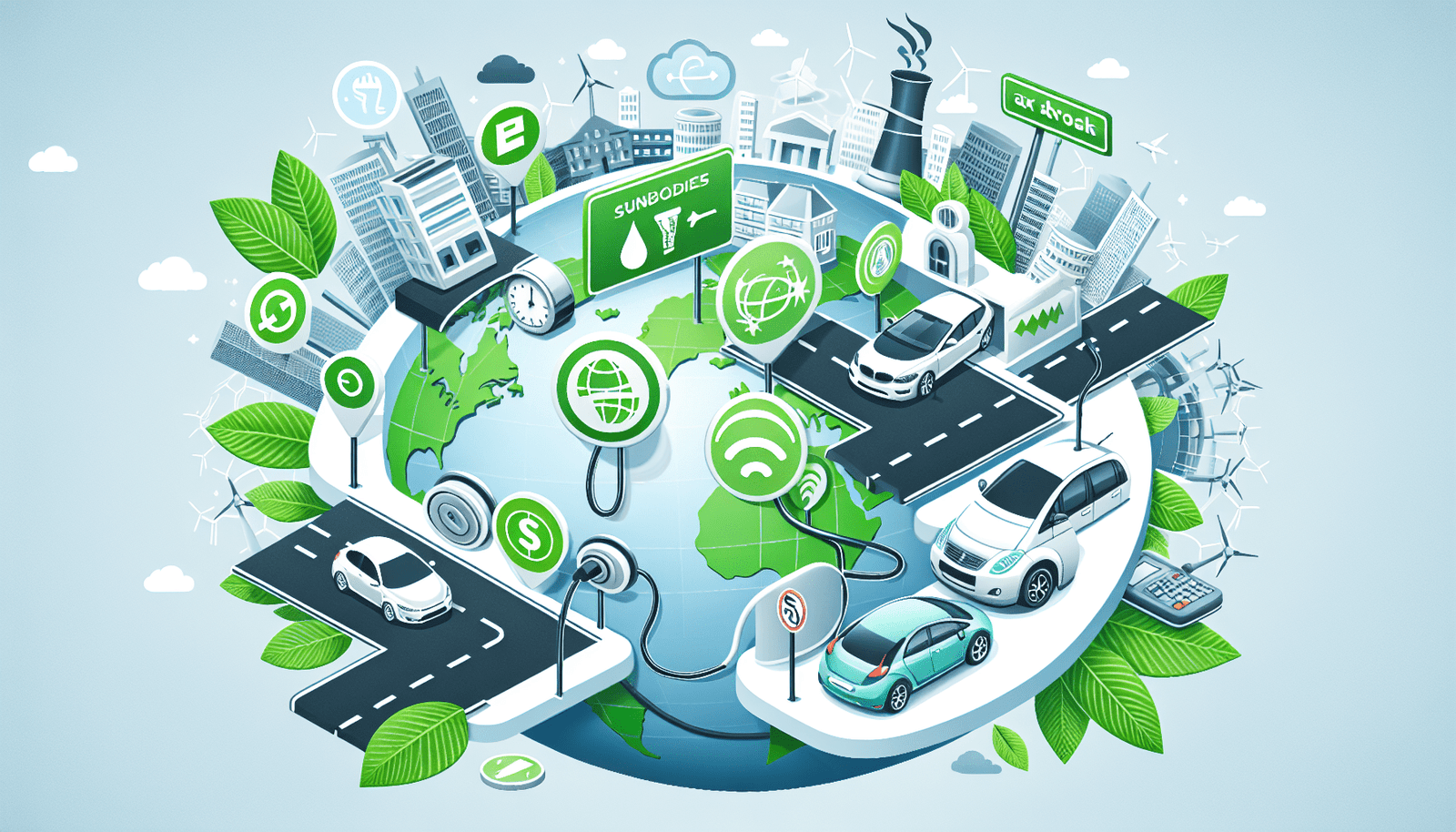In the realm of sustainable transportation, the rise of electric vehicles has sparked tremendous interest and hope for a greener future. However, one question looms over the minds of many: are there government policies in place to encourage the growth and adoption of electric vehicles? Delving into this topic, this article explores the efforts made by governments around the world to promote electric vehicle sustainability, offering an insight into the various policies implemented and their impact on shaping the future of transportation.
Financial Incentives
As governments around the world recognize the importance of transitioning to electric vehicles (EVs), they have implemented various financial incentives to encourage individuals and businesses to adopt sustainable transportation options. Tax credits are a common form of incentive, providing individuals with a reduction in their tax liability when they purchase an EV. Not only does this make EVs more affordable for consumers, but it also helps to stimulate the market for these vehicles.
In addition to tax credits, purchase rebates are another effective way for governments to promote the adoption of EVs. These rebates are typically given at the time of purchase, providing an immediate financial incentive for individuals to choose an EV over a traditional gasoline-powered vehicle. By reducing the upfront cost of an EV, governments are making it easier for more people to make the switch to sustainable transportation.
Grants and subsidies are also important tools for governments to promote the growth of the EV market. These financial incentives can be used to support the development and deployment of EV charging infrastructure, as well as encourage the adoption of EVs in specific industries or regions. By providing funding for EV-related projects, governments can accelerate the transition to sustainable transportation and create a more supportive environment for EV owners and drivers.
Infrastructure Development
One of the key challenges to widespread adoption of EVs is the availability of charging infrastructure. Governments play a crucial role in addressing this challenge by investing in the development of charging stations. By strategically placing charging stations in public parking lots, shopping centers, and along major highways, governments can ensure that EV owners have convenient access to charging facilities. This not only alleviates range anxiety for EV drivers but also supports the growth of the EV market.
In addition to charging stations, governments can also support the expansion of the electrical grid to accommodate the increasing demand for electricity from EVs. This grid expansion is necessary to ensure that EVs can be charged in a timely manner without putting excessive strain on the existing electrical infrastructure. By investing in grid expansion and upgrades, governments can create a more reliable and efficient charging network for EVs.
Battery swapping facilities are another important aspect of EV infrastructure development. These facilities allow EV owners to exchange their depleted batteries for fully charged ones, eliminating the need for lengthy charging times. By supporting the establishment of battery swapping facilities, governments can further enhance the convenience and practicality of EV ownership.

Emission Standards
To effectively combat climate change and reduce air pollution, governments have implemented various emission standards that directly impact the automotive industry. Zero-emission vehicle (ZEV) mandates are a powerful tool for promoting the adoption of EVs. These mandates require car manufacturers to produce a certain percentage of zero-emission vehicles to comply with regulations. By setting ambitious ZEV mandates, governments can push car manufacturers to prioritize the production and innovation of EVs.
In addition to ZEV mandates, governments also enforce tailpipe emission regulations to limit the amount of harmful pollutants emitted by vehicles. By setting strict limits on tailpipe emissions, governments can encourage car manufacturers to develop cleaner and more efficient vehicles. These regulations not only benefit the environment but also contribute to improving air quality and public health.
Research and Development
Investment in EV technology is crucial for driving innovation and improving the performance and affordability of EVs. Governments can support research and development in various ways, such as providing funding for research projects and establishing collaborative partnerships with industry. By investing in EV technology, governments can accelerate advancements in battery technology, charging infrastructure, and other key areas, making EVs more attractive and practical for consumers.
Collaboration between governments and the EV industry is also vital for promoting research and development. By working together, governments and industry stakeholders can share knowledge and resources, leading to more effective and efficient research outcomes. Collaboration can take many forms, including joint research projects, knowledge-sharing initiatives, and the establishment of innovation grants. These collaborative efforts help to harness the expertise and experience of both government and industry, ensuring that research and development efforts are aligned with market needs and priorities.

Education and Awareness
Promoting education and awareness about EVs is an important aspect of government policies aimed at encouraging sustainable transportation. Public campaigns play a key role in educating the general public about the benefits of EVs and dispelling common misconceptions. These campaigns can raise awareness about the environmental benefits, cost savings, and technological advancements of EVs, helping to change public perception and increase acceptance of these vehicles.
EV promotion events are another effective way for governments to engage with the public and showcase the latest EV models and technologies. By organizing events such as EV expos and test drive opportunities, governments can provide firsthand experience and information to individuals who may be considering purchasing an EV. These events allow potential buyers to interact with EV experts, ask questions, and gain a better understanding of the benefits and features of EVs.
Driver training programs are also important for promoting the adoption of EVs. By offering training courses specifically tailored to EV drivers, governments can ensure that individuals have the knowledge and skills necessary to confidently operate and maintain these vehicles. Driver training programs can cover topics such as EV charging, range management, and maximizing battery efficiency, helping to address any concerns or uncertainties that potential buyers may have.
Incentives for Car Manufacturers
Governments can provide various incentives to car manufacturers to encourage the production and sale of EVs. Low or zero-emission vehicle credits are a common form of incentive, allowing car manufacturers to earn credits for producing and selling EVs. These credits can be used to offset the production and sale of conventional, higher-emission vehicles. By providing incentives for car manufacturers to produce EVs, governments can help drive the transition to sustainable transportation and support the growth of the EV market.
Investment grants are another way for governments to encourage car manufacturers to invest in EV technology and infrastructure. These grants can be used to support the construction of EV manufacturing facilities, research and development initiatives, and the expansion of charging infrastructure. By offering financial support to car manufacturers, governments can reduce the initial costs and risks associated with transitioning to EV production, making it more attractive for manufacturers to invest in sustainable transportation.
Production quotas are another effective tool for governments to incentivize car manufacturers to produce a certain number of EVs. By setting quotas that require a specific percentage of a manufacturer’s production to be EVs, governments can drive the market demand for these vehicles. Production quotas not only encourage car manufacturers to prioritize the development and production of EVs but also contribute to the long-term sustainability of the industry.
Support for Battery Technology
Battery technology is a critical component of EVs, and governments can provide support to advance this technology. Research funding is an important form of support, providing financial resources for scientists and engineers to conduct research on battery materials, design, and manufacturing processes. By investing in battery technology research, governments can accelerate advancements in energy storage, making EVs more efficient, affordable, and reliable.
Battery recycling programs are another important aspect of government support for battery technology. These programs ensure that end-of-life EV batteries are properly recycled and their valuable materials are recovered. By incentivizing and supporting battery recycling, governments can reduce the environmental impact of EVs and promote a circular economy for battery materials.
Domestic manufacturing incentives are another way for governments to support battery technology. By offering financial incentives or tax breaks to companies that manufacture batteries domestically, governments can encourage the growth of a domestic battery industry. This not only strengthens the national economy but also ensures a reliable supply chain for EV batteries, reducing dependence on foreign imports.
Collaboration with Energy Sector
Collaboration between the EV industry and the energy sector is crucial for maximizing the environmental and economic benefits of EVs. Governments can facilitate partnerships between EV manufacturers and renewable energy companies to promote the integration of clean energy sources into EV charging infrastructure. By using electricity generated from renewable sources, EV charging becomes more sustainable and contributes to further reducing greenhouse gas emissions.
The integration of EVs into smart grids is another important area of collaboration between the EV and energy sectors. By connecting EV charging infrastructure to smart grids, governments can optimize the charging process, manage energy demand, and provide incentives for EV owners to charge their vehicles during off-peak hours. This not only reduces strain on the electrical grid but also promotes the use of renewable energy during times when it is most abundant.
Time-of-use electricity tariffs are another effective way for governments to collaborate with the energy sector in promoting the adoption of EVs. These tariffs incentivize EV owners to charge their vehicles during periods of low energy demand and thus lower electricity costs. By aligning the charging behavior of EV owners with grid capacity and renewable energy generation, governments can encourage more sustainable charging practices and reduce the overall environmental impact of EVs.
Institutional Changes
Government fleet electrification is an important institutional change that demonstrates leadership and commitment to sustainable transportation. By converting government-owned vehicles to EVs, governments can lead by example and demonstrate the practicality and benefits of EVs. Government fleet electrification not only reduces greenhouse gas emissions but can also result in cost savings and lower maintenance requirements for the public sector.
Policy procurement guidelines are another institutional change that governments can implement to promote EV sustainability. By integrating sustainability criteria into public procurement processes, governments can prioritize the purchase of EVs and other low-emission vehicles. This sends a clear signal to car manufacturers and the market that there is demand for sustainable transportation solutions, driving further innovation and investment in EV technology.
Green energy purchase mandates are a powerful institutional change that governments can implement to support renewable energy and EVs. By requiring government entities and agencies to purchase a certain percentage of their energy from renewable sources, governments can create a market demand for renewable energy and drive the growth of the renewable energy sector. This, in turn, supports the integration of clean energy into the charging infrastructure for EVs.
International Cooperation
International cooperation is essential for addressing the global challenges of climate change and air pollution. Government policies aimed at promoting electric vehicle sustainability can incorporate international cooperation in various ways. Global EV policy harmonization aims to align the regulations and standards for EVs across different countries. This helps to create a level playing field for car manufacturers and facilitates the global adoption of EVs.
Bilateral agreements between countries can also play a role in promoting EV sustainability. These agreements can include provisions for cooperation in research and development, sharing best practices, and promoting the adoption of EVs. By fostering bilateral partnerships, governments can facilitate information exchange and collaboration to accelerate the transition to sustainable transportation.
Information sharing initiatives are another valuable aspect of international cooperation. Governments can establish platforms for sharing knowledge, research findings, and technological advancements related to EVs. By sharing information, governments can learn from each other’s experiences and promote the adoption of best practices, helping to accelerate the global transition to sustainable transportation.
In conclusion, government policies play a crucial role in promoting electric vehicle sustainability. Financial incentives, infrastructure development, emission standards, research and development, education and awareness, incentives for car manufacturers, support for battery technology, collaboration with the energy sector, institutional changes, and international cooperation all contribute to creating a supportive environment for EVs. By implementing these comprehensive policies, governments can drive the transition to sustainable transportation and contribute to a cleaner and more sustainable future.

